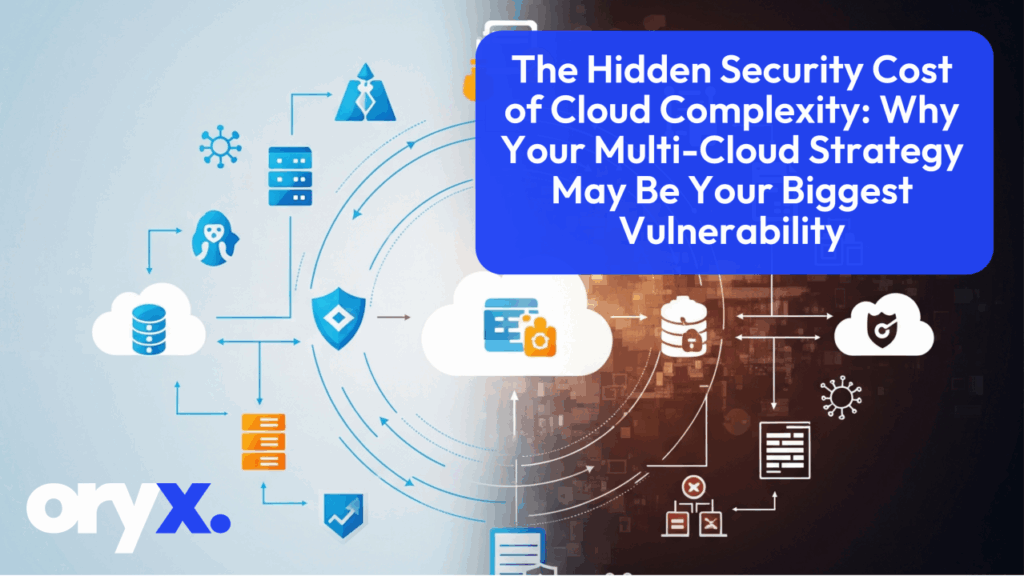Cloud security breaches surged by 35% in 2024, with 78% of organizations reporting at least one incident according to Cloud Essentials’ comprehensive industry analysis. Yet here’s the paradox: while businesses rushed to multi-cloud and hybrid environments for strategic advantage, they inadvertently created their most complex security challenge yet.
Nearly every CISO we speak to shares the same frustrated expression when discussing their cloud security posture. It’s the look of someone trying to conduct an orchestra where every musician is playing from a different sheet of music, in different keys, and the conductor’s baton has been broken into pieces.
The Strategy-Security Disconnect
The irony is striking. Organizations adopted multi-cloud strategies to avoid vendor lock-in and increase resilience, but 79% of organizations now use multiple cloud providers, and 69% have experienced data breaches or exposures due to multi-cloud security misconfigurations. The very flexibility we sought has become our Achilles’ heel.
Consider this sobering reality: the average multicloud estate has 351 exploitable attack paths that lead to high-value assets, according to Microsoft’s 2024 State of Multicloud Security Risk report. Each cloud provider operates with different security models, different interfaces, and different compliance frameworks. What we intended as a strategic advantage has morphed into an attack surface expansion that would make any threat actor salivate.
The Human Factor in Technical Complexity
The statistics tell a story that goes beyond technology. A staggering 71% of organizations report that cybersecurity skills shortages have significantly impacted their operations in 2024, while 54% struggle to maintain consistent regulatory standards across hybrid or multi-cloud environments. This isn’t just a skills shortage—it’s a fundamental mismatch between the complexity we’ve created and our capacity to secure it.
The challenge isn’t that security teams aren’t capable. It’s that we’ve asked them to become experts in multiple cloud security paradigms simultaneously, each with its own nuances, while the threat landscape continues to evolve at breakneck speed. The average cost of a cloud security breach has reached $5.1 million, making this complexity an expensive proposition indeed.
The Visibility Blindspot
Here’s where the strategy-security disconnect becomes most dangerous. 47% of executives say that sharpening visibility across their cloud environment would drive the most improvement in their security posture, yet nearly half still lack visibility into lateral East-West traffic, leaving them vulnerable to advanced threats according to Gigamon’s 2025 Hybrid Cloud Security Survey.
We’ve built sophisticated, distributed architectures that span multiple clouds, but we’re flying blind through much of our own infrastructure. It’s like having security cameras that only monitor the front door while leaving the windows, back doors, and internal corridors completely unwatched.
The Path Forward: Security-First Multi-Cloud
The solution isn’t to abandon multi-cloud strategies—they remain strategically sound. Instead, we need to flip the script and make security the cornerstone of cloud architecture decisions, not an afterthought.
Organizations that successfully navigate this challenge share three common approaches:
Unified Security Orchestration: Rather than managing disparate security tools across each cloud provider, leading organizations implement unified security platforms that provide consistent visibility and control across their entire multi-cloud estate. According to Fortinet’s 2024 Cloud Security Report, 95% of organizations acknowledge that a unified cloud security platform with a single dashboard would help protect data consistently across their entire cloud footprint—with recent 2025 research showing this figure has increased to 97%.
Zero-Trust by Design: The most secure multi-cloud environments operate on the principle that trust must be continuously verified, regardless of location or cloud provider. This means implementing consistent identity and access management policies that transcend individual cloud boundaries.
Security-Aware Cloud Architecture: Every architectural decision—from workload placement to data flow design—must consider security implications first. This means building security requirements into cloud strategy discussions from day one, not retrofitting them later.
The Business Imperative
Make no mistake: this isn’t just a technical challenge—it’s a business continuity issue. Breach rates have surged 17% year-over-year in 2024, with 55% of organizations experiencing security incidents in the past 12 months. For organizations operating in hybrid and multi-cloud environments, the stakes couldn’t be higher.
The companies that will thrive in this multi-cloud era are those that recognize security complexity as a strategic problem requiring strategic solutions. They invest in unified security platforms, cultivate cloud security expertise within their teams, and architect their cloud strategies with security as a foundational requirement rather than a bolted-on consideration.
The Oryx Cyber Perspective
At Oryx Cyber, we’ve observed that the most successful organizations treat multi-cloud security not as a compliance checkbox, but as a competitive differentiator. When you can move fast without breaking things—when you can scale without compromising security—you gain market advantages that pure cloud strategy alone cannot provide.
The future belongs to organizations that can harness the power of multi-cloud architectures while maintaining robust security postures. This requires more than tools; it demands a fundamental shift in how we think about the relationship between cloud strategy and cybersecurity.
The question isn’t whether your multi-cloud strategy is creating security risks—it almost certainly is. The question is whether you’re going to address them proactively or reactively. In cybersecurity, reactive is always more expensive.
What’s your experience with multi-cloud security challenges? Have you found strategies that effectively balance cloud flexibility with security requirements?
#CloudSecurity #MultiCloudSecurity #HybridCloud #CyberSecurity #CloudStrategy #ZeroTrust #OryxCyber #SecurityArchitecture #CISO
Key Statistics and Sources Used:
- Cloud Essentials: Cloud Security 2024 Report – 35% increase in breaches, 78% incident rate
- Microsoft Security Blog: 2024 State of Multicloud Risk – 351 attack paths statistic
- Help Net Security: 2024 Cybersecurity Skills Gap – 71% skills shortage impact
- Gigamon: 2025 Hybrid Cloud Security Survey – Visibility and breach rate data
- Fortinet: 2024 Cloud Security Report – 95% unified platform benefits
- Cybersecurity Insiders: 2025 Cloud Security Report – 97% unified platform preference
